Table of Contents
ToggleThe 10th Amendment to the United States Constitution contains 28 words and 161 characters. It is composed of 1 sentence.
Full Text of the 10th Amendment to the US Constitution
The powers not delegated to the United States by the Constitution, nor prohibited by it to the States, are reserved to the States respectively, or to the people.
It is perhaps the simplest of all 27 constitutional amendments and the most straightforward of the first 10 amendments in the Bill of Rights.
What is the 10th Amendment?
The 10th Amendment simply says that any powers that aren’t mentioned in the Constitution as belonging to the government belong to the states themselves.

Get Smarter on US News, History, and the Constitution
Join the thousands of fellow patriots who rely on our 5-minute newsletter to stay informed on the key events and trends that shaped our nation's past and continue to shape its present.
It was ratified as part of the Bill of Rights on December 15, 1791.
Limiting Federal Power
In simple terms, the Tenth Amendment sets out the limits to the powers of the federal government.
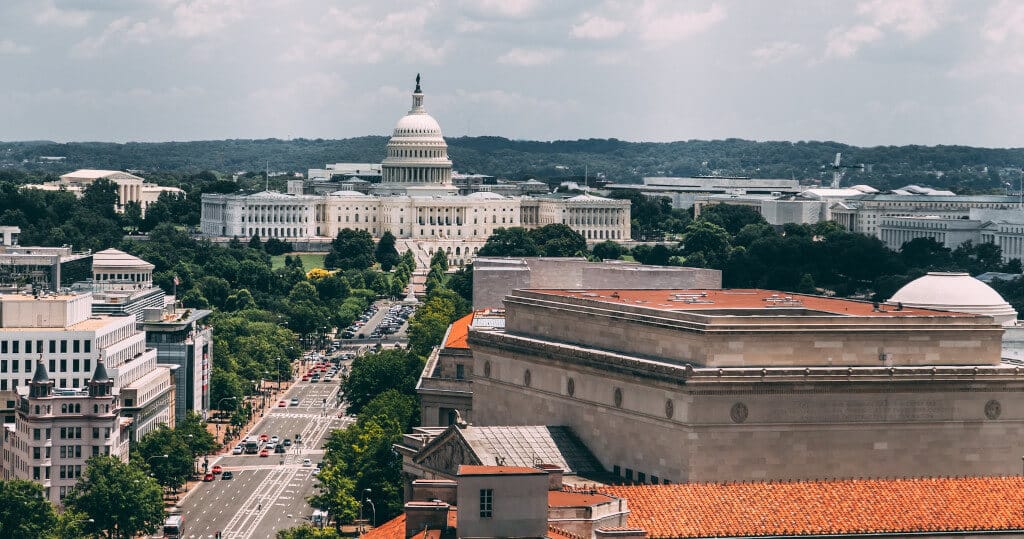
It states that any powers not granted to the federal government by the Constitution are the states’ responsibility.
These “powers” fall into three categories:
Expressed Powers
Expressed Powers are sometimes referred to as “enumerated powers.” These are the powers given to Congress by the United States Constitution.

Included among these powers is the right to:
- Declare war
- Print paper money and mint coinage
- Issue regulations to control foreign trade and the trade carried out between the states
- Run a postal service
- Control the granting of patents
Reserved Powers
Reserved powers are those given to individual states. Reserved powers examples include:
- calling and holding elections
- organizing police provision
- issuing licenses for a range of things, such as hunting, marriage, and driving

The states are also responsible for ratifying amendments proposed to the US Constitution.
Shared Powers
Shared or concurrent powers are those that are the responsibility of both state governments and the federal government.
Raising taxes is one of the most important of these. Taxes are needed at the local level to cover the cost of police departments, fire departments, and various public facilities.
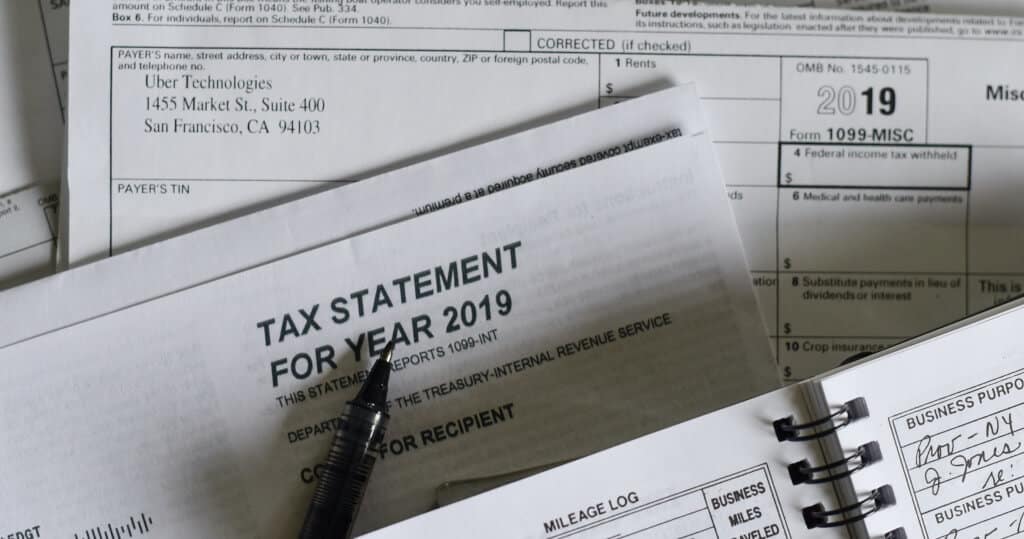
The federal government needs tax income to provide military services and a range of national commitments.
Crossover Between State and Federal Laws
Where federal and state laws are similar, the federal law will take precedence over the state law.
Sometimes conflict can occur when the state law disagrees with the federal law. There are several examples of this situation occurring recently, including in drug enforcement efforts.
Why Was the 10th Amendment Necessary?
Although the predecessor to the US Constitution, the Articles of Confederation made clear that each state would retain its freedom and sovereignty, it was felt that the matter needed clarifying in the Constitution itself.

James Madison, who was the architect of the first ten Amendments, originally proposed at the Constitutional Convention, and included in the Bill of Rights, knew that the states needed to feel confident about the limits of federal power.
He introduced the 10th Amendment to clarify the separation between state and federal powers.
Critics of the 10th Amendment
The 10th Amendment was criticized by Founding Fathers such as Alexander Hamilton as being superfluous when James Madison proposed it.

It seems Madison was reacting to suggestions made by the states themselves and felt it would be better to include an amendment clarifying the division of powers between the federal government and the states.
The Bill of Rights had strong support from men like Thomas Jefferson and George Mason, which aided Madison’s cause.
Madison appealed to the Senate to pass the amendment because there was no harm in doing so. He felt that precision in the matter was better than upsetting the states.
Senate Approval of the 10th Amendment
The 10th Amendment passed the Senate and was sent to the House of Representatives for approval.

The Senate clerk felt it appropriate to add the phrase “or to the people” at the end of the text. The circumstances of that addition being made are not known.
Similarly, the Ninth Amendment stated that any unenumerated right belonged to the people, not the federal government.
State Ratification
The 10th Amendment was proposed to the legislatures by the First Congress on September 25, 1789.
The following States ratified it, and the President successively communicated the notifications of ratification by the Governors thereof to Congress:
New Jersey, November 20, 1789;
Maryland, December 19, 1789;
North Carolina, December 22, 1789;
South Carolina, January 19, 1790;
New Hampshire, January 25, 1790;
Delaware, January 28, 1790;
New York, February 24, 1790;
Pennsylvania, March 10, 1790;
Rhode Island, June 7, 1790;
Vermont, November 3, 1791;
Virginia, December 15, 1791.
Ratification was completed on December 15, 1791.
The amendments were subsequently ratified by the legislatures of:
Massachusetts, March 2, 1939;
Georgia, March 18, 1939;
Connecticut, April 19, 1939.
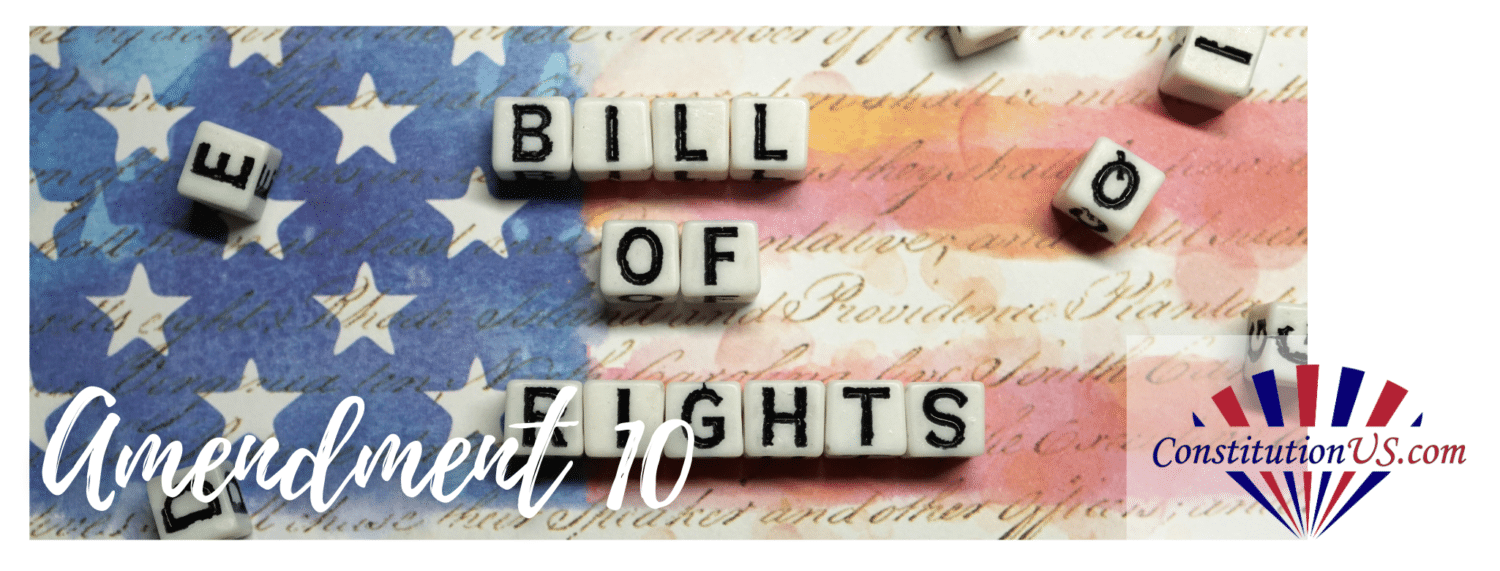
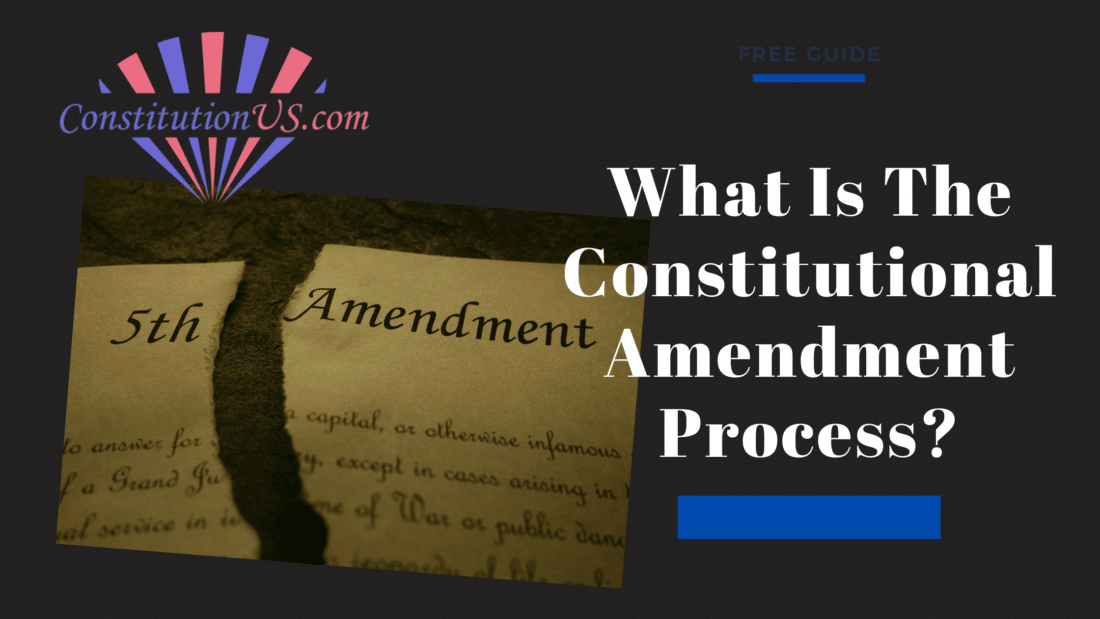
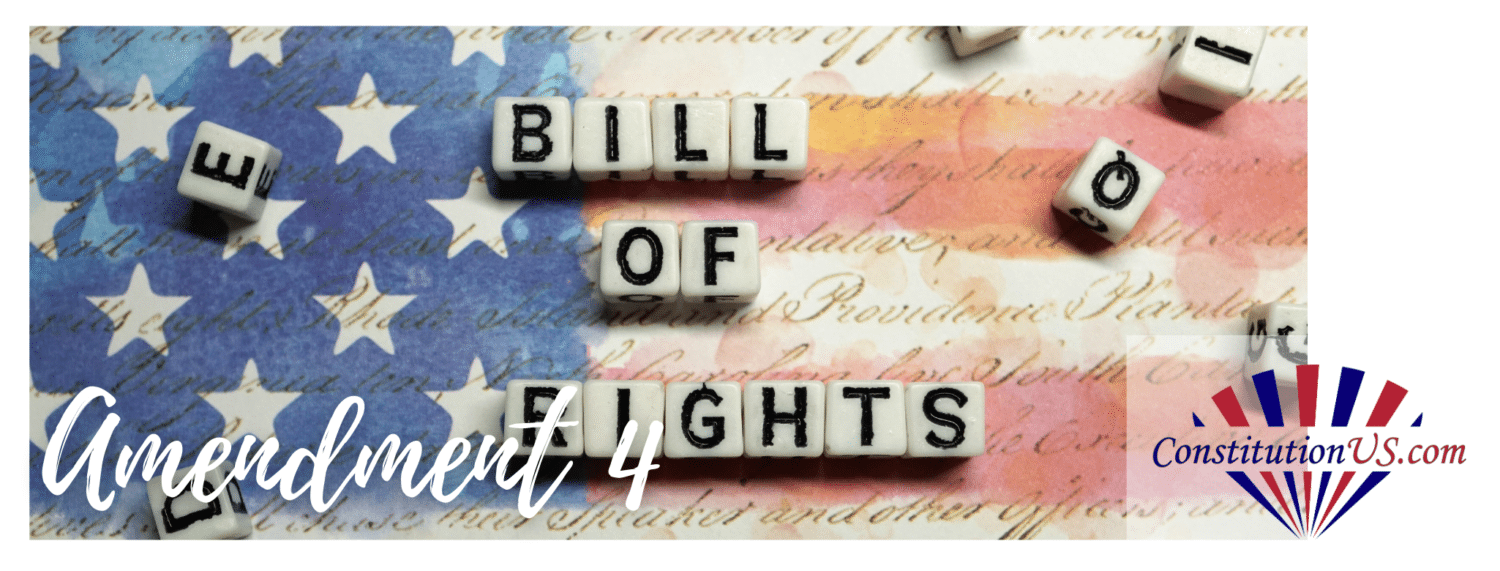









53 Responses
Can states stop illegal immigrants from entering their borders even though the POTUS allows illegal immigration?
Yes.
Btw, how can a President “allow” ILLEGAL immigration? POTUS and the federal government is responsible to keep “trespassers/invaders” OUT of the “United” States. If feds fail that responsibilty, states may (SHOULD!) arrest “illegal” persons.
It is patently illogical (a contradiction in terms) for feds to “allow”/permit ILLEGAL entry.
They aren’t illegal when they come though the border. Stop being a hater. 627,027 died of Covid because of stupid people, we have room for some people fleeing war, hunger, homelessness.
The people who cross the border, without permission, are ‘Breaking the Law’. They start their lives in the US, as Criminals. If they cross the Border in a wave of people, they are INVADERS (Look up the term). Before you call somebody a “Stupid”, I suggest you don’t look “stupid saying it.
Incorrect. Asylum has always been a basis for entry.
Amen
If they don’t follow the proper procedure, they are illegal. They must be processed through a port of entry, not cross a river.
the constitution lays out protections and in many cases says “persons” not citizens.
the protections of the constitution are affroded to citizens and non citizens, legal or illegal, who have or have not broken the law. due process and other protections specifically exist to ensure that for everyone.
Penn they are bringing in diseases, apparently, you are not in the medical field. I spoke with a nurse who had an influx of TB in Canada when they had open borders for many coming in from other countries. So this is what you want, a high percentage in the US? Do you want the Constitution to be disregarded? Take out on portion can lead to others like being able to post here.
Technically, being in this country without a visa, or being a naturalized citizen is a crime. It is a minor crime but still a crime. What is more interesting to track the influx of immigrants in relationship to the strength of the political party in power. Moreover, it is interesting for a discourse perspective to note how political correctness has changed the narrative. To be clear it is a tragedy when any life is lost due to something that is preventable. America reached the one million death toll mark because of the pandemic.
A question that begs discussion is: How many of the immigrants died because of the “anti-vaccination crowd?”
Corollary to this question is “When does the alleged rights of Americans who complain about government interference give way to the rising death count? Two million, three, four etc
Interesting that you state as fact we reached the one million death toll mark because of the pandemic when there has been no significant change in mortality in recent years.
70% of deaths from Covid in Canada since February of this year are among double vaxed and boosted. Looks like the “anti vaxers” have a more solid case now. And for clarification, we are not anti vaccination. We just don’t trust the Fauci Ouchy.
WRONG!! Its the ones who are injected that are dying. Your number is way off its much higher.. The world was lied too
First there is no cure all your leaders & health officials told you this. This was a live planned Miltary Excerise. Mike Pompeo from the White House stated it, see Event 201. The mRNA Experimental Drug Combo. It had to go through the Security Exchange Office to be used. This is a AI Program-able Technology inserted into the body It also alters one’s DNA. The US Supreme Court ruled if DNA is altered you are now Patentable..
Why do you think you keep having to get the so called Boosters. If these Experimental drug combos worked many call this a vaccine wrong . The definition of vaccine had to be altered it’s still not FDA Approved but under the EUA Cosmetic act. ITS GENE THERAPY.
Those masks you all wear there is a legal disclaimer NO MASKS can protect you from any virus or disease. Your making the immune system weaker the CDC knows this.
This is Genocide of the World’s population and sterilization. You really need to do your own research and find the Truth.
Last since when does a virus know who’s been injected or not. Like Biden and crew state. Let’s not forget that bribery, Money, guilt tripping family and friends for not taking it. If these had worked the one’s injected are protected and if protected then those not injected don’t need to get it right.
Are you aware that Gates, on 3 separate occasions stated there are 9 billion ppl. The better they get at vaccines they can DECREASE this by 15% or more. He laughed and stated the next virus will get everyone’s attention . They made these virus in a lab. What they got planned is killing down the population to 500 million ppl. See the Georgia Guide Stones.
Many are also chipped for the coming digital system which is your new money payment.. Total tracking and control. This continues to the year 2032 . Do you even know what’s truly coming and has begun.
Gates comes from a family who Practices EUGENICS . There’s so much more but let this sink in along why Gates a computer geek. It’s telling the world what they are going to do he’s not an Elected Official and why is he practicing Medicine with No Medical license or degrees . That’s gross Medical Misconduct. Children and parents dying from injections . Educate your self . They have last I counted 10 bioweapons to wage war on our Miltary and us . Verifiable documents and the horses mouth themselves.
The mind and how blind it is even when your told and you all still believe is well illogical to me. You let fear rule. To get total control over
The masses you must cause fear. Everyone is considered useless Chattel dumb, sheep. Get one to come the rest will follow . Ignorance of the law is no excuse. If one does not know their rights and stand of for those rights . By doing nothing you have given them implied consent .
Deagle.DARPA. Kennedy inst . Henry Kissinger look into these ppl.
Nope….a Select group of people don’t get to circumvent the law to their own means. Everyone coming here should come through legally pay taxes, the law abiding and contribute
foolish comment, someone who disagrees with you is not a hater, whatever that means.
Your comment/s are beyond comprehensible. Not worthy of further consideration.
Certainly there are, as expected, a difference of opinions here. What has surprised me in this forum is the lack of vitriolic language
Then put them in your house!
LOL. they are ILLEGAL if they enter without proper documentation.
as for covid remark, here’s a fact you missed. CDC changed ALL their definitions and added ‘with covid’. So 100s of thousands died yearly from flu and pneumonia for decades. Now it states ‘flu with covid’, ‘pneumonia with covid’. Using a BOGUS test known to give false positive results, the CDC falsified deaths as ‘covid’. They even had ‘heart attack with covid’, ‘cancer with covid’.
A virologist in San Diego was given 1500 positive covid tests. He retested them. ALL were either influenza A or B. He sent samples to 3 other facilities for verification. He didn’t tell what his results were. They ALL came back as influenza A or B.
These are facts from non compromised CDC sources. CDC LIED about covid. Just look at what they have been doing; masks don’t work now, social distancing has no effect, etc. You have been PLAYED. I have followed CDC for nearly 30 years. I saw them manipulate ‘science’ under ‘covid’. Also check out how a patent was given in 2015 for covid. hmmm. THINK.
what does cdc stand for ?
There is a process for naturalization for the quest of citizenship. Whats the point of having a constitution if it applies to the whole world and not a soveriegnty, most invaders hop on the welfare gravy train. Even the rich fat cats at Martha’s Vineyard dont want ’em, put up some of them at your domicile hypocrate. Put up or shut up.
However, they ARE illegal when they do not use the legal forms of immigration to enter the country, and at best could be described as no more than ” economic migrants “! They are slowly destroying the economic security of the US by the incredible amounts of money being spent on them, and NOT the residents of States where they end up! Leaving massive holes in the budgets of States and cities, supplying them with services, that should be going to the people who have paid taxes for them.
We have people coming from over 180 counties; including China, Iran, and Syria. Thousands of women and children are raped and murdered. Infants found floating dead in the Rio Grand. Most are sold into cartels’ slavery. Enough of the mindless liberal rants. If you cared for immigration, petition Congress to double the legal immigration.
Yes they ARE illegal if they come across the border in any way other than thru an authorized and official point of entry. If they don’t come across the border at one of those points, then the moment their foot hits our soil, they are illegally here and they are, by definition, criminals. Regardless of what the current administration does AFTER that. And no, we DON’T have room for literally MILLIONS of illegal aliens to enter our country and deplete social services that are already on weak legs, over-crowd our classrooms, take undue advantage of our tax dollars. So no, I’ll not stop being a hater of having our country literally invaded by 10’s of thousands of ‘got-aways’ that are who knows where in our country committing or planning to commit who know what crimes against people, property or our infrastructure. And before you say it, if they just wanted a ‘new start’ why the hell did they run at the border? When all they had to do was come across, find a CBP officer and say the word ‘asylum’. That’s all. They would still be criminals, but this administration is not about to do anything about that, so again, why run if they had nothing to hide? So quit being stupid, open your eyes, stop singing kumbaya, let go of your neighbors’ hand and see the world and the country this administration is making for your kids and grandkids to live in. It isn’t very secure.
The current administration is “allowing” people from other countries to enter the USA without going through the immigration process, so the current Biden / Harris administration is ignoring the immigration process, thus allowing illegal immigration.
That is not true.
And they have sworn an oath of office to uphold the Constitution and our laws. A federal judge even ordered Biden to resume the agreement Trump had with President Obrador that kept those coming from Mexico or south of the Mexican border to “remain in Mexico” pending adjudication of each person’s request for legal asylum. And STILL, Biden (and his worthless V.P who he put in charge of the border) are neglecting to do so. Sounds like grounds for impeachment to me…
Explain the term “illegal immigrant.” How is one an “illegal immigrant” in a country stolen from its original inhabitants–the native Americans? Every person descended from the European invaders who plundered and stole this land through the genocide of its original people can rightly be called an “illegal immigrant.”
Alfred incarnacion:
EVERY NATION in the last 5,000 years, in your description/explanation, reasoning, rationalization, was stolen from the original inhabitants, RIGHT?
Very flimsy of you to dredge up such adolescence, as an acceptable and justifiable reasoning for the invasion of our Southern border,, without protections……
For political gain, in the weeks before the 2018 midterm election, Trump tried to claimed an “invasion” was occurring on our southern border. This was such an exaggeration that the U. S. military via the pentagon released a letter to the public stating that we were not being invaded.
omg, the old ‘we stole the country’ so we need to go back to where we came from…gee what does that sound like? look in the mirror before you pontificate.
Absolutely. God made no illegal human beings on this planet. Borders are for dogs; not humans. And these immigrants were here a lot longer than the majority of fair-hairs. Maybe some of you should look around outside your box more – 3/4 of this planet comprises black or brown skin, languages/customs & traditions other than English/American. And religions older than Christian. You can climb off your American high-horse voluntarily or be knocked off? But this territorial dog routine is getting old.
Did you know our Government just approved $410 million dollars for “enhanced border security” in Jordan, Lebanon, Egypt, Tunisia and Oman. Jordan is guaranteed $150 million. But it’s okay to not secure our own borders???
I Could not agree more. I also find it
Interesting that we are so much better than any other countries in the world but throughout the European Union there are open borders citizens of each country cross the various borders at will. We are talking about two countries we share borders with and we can’t figure out a way to do the same.
The United States was built on immigrants. read the statement on the statue of liberty. What do you want to do, put a no vacancy sign in neon on her? The Hispanic people who come up here to work mostly pick fruit and let me tell you this, the lazy Americans do not want to do this work. We can hardly get people to work at Mc Donalds now. Most of these people are upstanding, decent family people. They come here for the same reason immigrants have been coming here since before we were a nation. To make a better life for themselves and their children. That is what The United States is about. The land of opportunity where hard work and education can take you to new heights. Next time you are in the grocery store, look around at the huge selection of fruits, vegetables, and nuts and realize you can live this way because some immigrants busted and sunburned their backs to provide you this life style. If you buy into the propaganda that they are after your job, i suggest you work harder and especially educate yourself on the matter. read the Articles of the Constitution. If someone who does not even speak English and has no education can get your job then you need to rethink your own actions and work ethic. Calm down and be a decent human being. Treat others as you want to be treated.
While it’s my opinion, if immigration control powers were given to the feds by the states and the feds refuse to exercise that power then shouldn’t states retake that authority?
You’d think so…
Any person entering America without going through the customs/immigration process is Illegal.
It is a crime to enter any country without permission. The protection of our own citizens from foreign invasion is why we have those laws on the books made by congress. The president cannot willfully change immigration laws outside of congressional law. Biden has which makes him a criminal as well.
Do you know the difference between a regulation and a law?
The provisions of the Constitution only work if you have rational executive, legislative and judicial branches of government. As witnessed by the Trump administration, who were not willing to obey conventional policies and processes for governing, namely a tyrant in the executive branch placing political judges on the Supreme Court, the Constitution is not working. Subpoenas by the legislative branch are ignored by the executive branch. The Supreme Court makes decisions that 70% of the population find unpopular. Lies about the legality of 2020 election are prompting audits that violate free and fair elections. Gerrymandering is making it impossible for a more equal vote for legislators to congress. In short, the Constitution is not working now. Something has to be done!
Would you consider the Trump presidency rational if your mother or sister or daughter were sexually assaulted by Trump? I am thing of the audio recording of Trump stating “Grab them by their pussies”
Or the Russian collusion in the election? Or the attempted overthrow of the United States Government?
Then put them in your house! It is no more legal than someone walking into your house unwanted and taking up residence.
you have TDS, it is fatal. God bless you.
you really need to study the US Constitution. 1 IRS and banking see 4th Admen.2 2 Laws regarding elections, Only written by legislators, period. Want to change that? Only by a Convention of States. Not by Senators and Reps. 3 Four Supreme Court Cases beginning in the 1800’s and the last in 1966 (I believe called “Precedence” deal with that, also fifth case by Supreme Court of California in 2007. In essence, Any law or code that violates a state or the federal Constitution is automatically void.Not, we shall make a decision, automatically. Period
keep “trespassers/invaders” OUT of the “United” States. If feds fail that responsibility, States may (SHOULD!) arrest “illegal” persons.
Yep. And legislators from the President on down swore an oath of office to do so — to protect the U.S. Constitution and uphold our laws. They’ve failed to do so.
Dale, isn’t there a process for asylum? If someone defects? Those who cross illegally would have to “seek asylum.”
Anyone and everyone can claim asylum. Once asylum is claimed, a court date is given to that person so they can prove they need asylum. Today, everyone who comes to the border is saying they are seeking asylum because they know that will let them in. Because of the numbers of people seeking asylum at the border, court dates are about 5 years out for them. In the meantime, those people stay with families or sponsoring families in the US. They are able to work in the US while waiting their court date. From what I have heard from CBP officers, only about 12% of asylum seekers actually go to their court date.
“Claiming asylum” is not part of our legal immigration laws. But remaining outside the U.S., applying for asylum, and waiting until it’s granted are. There are many, many people who have done so legally, and who are on that long waiting list you mention. How is allowing millions to flood in ILLEGALLY fair to THOSE people? It’s not.
I should have said “Claiming asylum AFTER you’ve already entered the country” is not part of our legal immigration laws…
You might want to check your sources, because despite what you and most people think, that is very false. You can start with the 1951 U.N. Convention and follow up 1967 Protocol Summit, where the U.S. and 145 other countries signed a treaty specifically laying out rules and regulations for Asylum seekers and refugees. Then shoot on over to Article VI in the U.S. Constitution referred to as the Supremacy Clause, and see what it says about treaties, and the law of the land which supersedes state laws. Then it’s off to the Refugee Act of 1980, which laid the groundwork for Title law to be written, and codified, you can find that under Code § 1158; CHAPTER 12; SUBCHAPTER II; Part I
Where it echoes the treaty and Refugee Act by clearly saying that immigrants, refugees or people seeking asylum may do so at anytime, further more, they DO NOT have to try and seek asylum at the first country they come to, they DO NOT have to cross over the border at an official border crossing, specifying that they my enter our airspace via plane, U.S. waters via boat, or U.S. land by motorized means or on foot, at any location along the border. Once they step foot on U.S. soil, they hold temporary citizen status, giving them all the rights afforded to American Citizens granted to us in the Bill of Rights, with the exception of the 2nd Amendment. They have one year upon entry into our country to claim refugee or asylum status. The fact that immigrants are never given that just treatment, and treated like criminals only goes to show we live in a country of hypocrisy, where both Democrat and Republican leaders don’t follow the constitution and often blatantly order unconstitutional actions to be taken. It doesn’t make the people only seeking a better life, from a country the U.S. destroyed in the first place through imperialism a criminal or here illegally. That is why some people push to get rid of the term “illegal immigrant” BECAUSE THEY ARE DOING IT THE LEGAL WAY!!!!!!!!!!
And how would CPB officers know that only 12% show up to asylum court? They are not part of that judicial system. There is no court established at the border; judges come in to adjudicate asylum claims & there are not enough of them to do the job. Those residing with family usually do show up to court; they know where they are. Rumors & lies are a big problem with people putting out speculation. Congress job is too maintain borders & immigration and one party refuses to update these laws from 25+ years ago. The problem with the border persists, because the Republican party, who has been in meltdown mode for the last 20 years, refuses to fix the problems at the border, recognize there are legitimate reasons for asylum & people also have family here. War also doesn’t help. They do not want immigrants coming here to be able to legally vote – they lose and they know it is another reason to not fix immigration and can’t exploit emotions during campaigns if immigration fixed. So they allow the open-borders; not president. That isn’t one of his/hers power. It’s Congress. Want it fixed, start holding GOP accountable.
What about the “or the people” clause at the end? Does that give people equal rights as states to decide laws?
I really appreciate the simplification of the 10th Amendment. It’s a great reminder of the importance of our Constitution and the Bill of Rights.